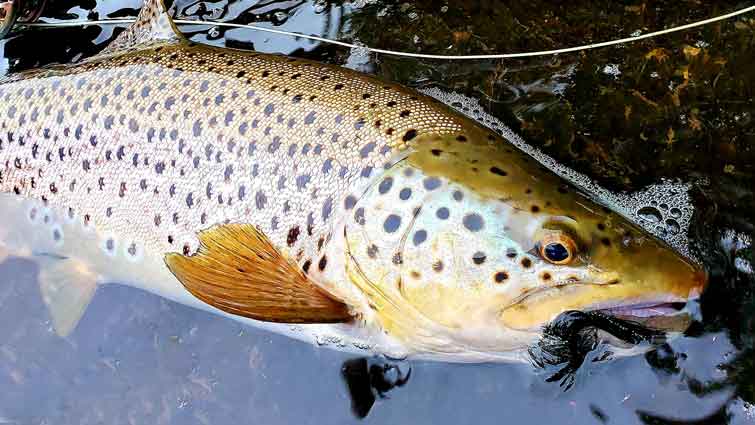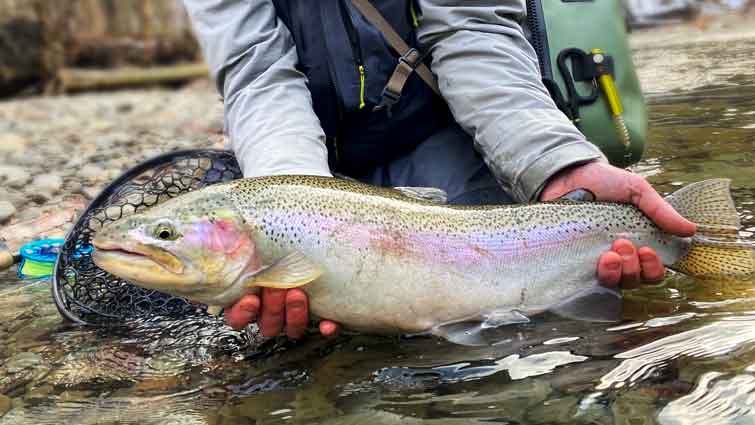Dry flies, as the name implies, float on the surface of the water. A fly that floats well is more likely to be taken by a fish than one that sinks or drifts along under the surface.
To make sure your dry fly floats properly, you need to choose the right materials and tie them tightly together. The addition of floatants to the fly is also a useful way to make sure it floats well.
Dry flies are tied with upright wings around hooks linked to some sort of elastic material, which allows them to be easily cast out onto the surface of the water without sinking immediately. Keep reading to learn more about how to make dry flies float on the surface of the water.

How to Make Dry Flies Float Better
Dry flies are designed to float on the surface of the water, but inevitably they sink or drift along under the surface. To make sure your dry fly floats properly, you need to choose the right materials and tie them tightly together. The addition of floatants to the fly is also a useful way to make sure it floats well.

Creating an upright wing for dry flies requires less work than wet-fly wings because there is no thread between the hook and eye as with wet flies, so instead, you can attach them without having them abrade each other as they rotate.
There are several kinds of material used to create a proper wing on a dry fly: deer hair, bucktail, elk hair, feathers, and others. Here, we will focus on the materials that are easily available to most fly tiers.
Dry Fly Materials
Dry flies are tied together using a variety of materials, from deer hair and synthetic fibers to chenille and wire. Here's a list of some of the most popular ones:
Synthetic Materials
These are usually made from UV-resistant nylon or polyester. The most popular form this takes is that of a dubbed body, on top of which sits a wing case made from tying thread. It's this dubbing method that makes the fly float so well.

Nylon has become very popular because it can be dyed in different colors so that you can get bright, vibrant patterns rather than natural neutral tones like browns and greens. Like deer hair, it's also very buoyant.
Synthetic materials aren't as good during winter months because they're not as affected by changes in temperature; however, natural materials are very sensitive to the freezing point of water.
Chenille
Chenille is another popular material for tying flies together because it has multiple uses. This is not only buoyant but also durable, allowing it to last through many fish strikes without ripping apart or getting worn down like some other types of materials could. It's perfect for making big game patterns that require a lot of movement in the water to entice prey.

Chenille is a type of decorative material used to make the bodies on flies. It's composed of several strands wrapped together, so it can be spun, allowing for bright color combinations. It creates an attractor pattern with its jigging motion in the water.
Wire
A stiffener made of copper or other metal that is added to fly patterns to keep them afloat. This wire has many different shapes and forms depending on what kind of fly it is being used on, but the most common are straight pieces that have been wound into scrolls or coils, which then wrap around the shank of the hook either parallel or perpendicular sides down. The unique shape helps create action in the water as the fly drifts.

Natural Materials
Deer hair is one of the most common natural materials used for dry-fly wings, but other types are possible, too. For example, Elk Hair has almost become a staple material for fly tiers because it's so buoyant and durable at the same time.

Other elk hairs are more streamlined, while still others have short hairs to imitate small insects or larva. You can even get colored deer hair that will stand out against darker backgrounds. It all depends on what you're trying to attract with your fly pattern.
Natural materials are more buoyant because they have hollow cores, while synthetic materials are solid throughout their entire thickness. Natural materials can also be challenging to work with because you'll need to dry them before use, and they may become waterlogged if they get wet. On the other hand, synthetic materials do slightly better during windy conditions.
Using Floatant to Help Dry Flies Float Better
To make them more buoyant, simply coat your dry flies with floatant before you go fishing. You can choose from options made specifically for synthetic or natural materials. A good quality float requires only a single application because it lasts so long.

This product is used to help dry flies float better on the surface of the water. It comes in a paste or liquid form and is spread over the body of the fly, which then creates an invisible barrier that helps stop it from absorbing water and sinking.
Floatant is an oily lubricant that is applied directly onto the fly. Floatant creates a coating of water-repelling gel around the fly. It should only be applied when the fly is dry. It is crucial to make sure you put on the floatant before any water touches the fly. This gel coating will help the fly to float.

It isn't always necessary to apply Floatant depending on what type of conditions or waters one will be fishing. For instance, rivers that are flowing incredibly quickly may not need any Floatant at all. For most cases, though, a little of a few types will help out.
Listed below will be a few tips and tricks for applying floatant to dry flies:
- Shake the bottle of Floatant before using it (the ingredients want to settle)
- Make sure that your hands are not wet when handling the Floatant.
- If you add too much Floatant, or apply it directly onto the fly, then use a dry cloth or tissue to wipe off any excess. Otherwise, the matting of fibers after packing with dubbing can be affected and make tying more difficult. The fly should still be able to move freely in the water with ease.
There are multiple types of floatant. Powder, Cream, or liquid are most common. Also, some work better on some materials than others do.

It isn't always necessary to apply Floatant depending on what type of conditions or waters one will be fishing. For instance, rivers that are flowing incredibly quickly may not need any Floatant at all. For most cases, though, a little of a few types will go a long way.
There are unique pros and cons of:
- Liquids
- Powders
- Creams
Powders are the most commonly used type of Floatants because they typically stay on flies longer than other types. Liquids can be useful in some instances but often attract fish when fishing in lower light conditions or cause dirt to accumulate around the fly in high lights. Creams aren't really used much at all due to their inconsistency.
Cream floatants work best for small flies that require a thin layer of wax to cover them well rather than a thicker coating that you would need with a liquid or powder version. Also, creams typically don't last as long as powders because they offer less protection from the elements.
Liquid floatants are by far the easiest to use when treating dry flies because you simply add drops from a dropper bottle. However, they do have their limitations. For one thing, liquids generally contain soapy ingredients, which may actually attract fish during low-light conditions and attract dirt and debris in high-light conditions.
This matting effect on your flies could reduce their buoyancy and cause tangling problems when fishing with wet flies or nymphs that sink very deep and fast. Also, liquids float for a short period of time and don't usually stay on the fly as long as powders do.

How Do You Make Dry Fly Floatants?
If you love creating things and saving money at the same time, making your own DIY dry fly floatant is a fun project to do over the weekend. Keep in mind, though, that since most dry flies require only a tiny amount of floatant to keep them afloat, a bottle of Gink costs just under $6 and will last a long time.
One common recipe for homemade Floatant is to mix petroleum jelly with shavings of beeswax until it gets a gelatinous consistency. Then place it into an empty container that you have lying around or bought specifically for this project.
You can use any type of container that is clean enough to put food in later on down the road after the Floatant has cured, but for now, just use something disposable like a plastic baggie or small drinking cup. Stirring sticks are typically used in these projects, but you can use just about anything that will allow you to mix the ingredients well.
How Do You Make Dry Flies More Visible?
Changing materials may often enhance the visibility of a dry fly. Choose white parachute posts or wings that have been fluorescently dyed and visible wings. For a Comparadun, use bleached deer hair, or choose crinkled Hi-Vis material for spinner wings.
Do Dry Flies Sink?
When a dry fly is damp with water, it sinks. To keep it afloat, use a desiccant to dry it out and apply a floatant gel-like Gink. Changing flies on the stubborn fly that refuses to float may be the best remedy. There's a lot more to maintaining a fly on top of the water than meets the eye.

Conclusion
When you're fly fishing, it's important that your dry flies float properly. You can do this by choosing the right material and tying it tightly together to avoid sinking or drifting along under the surface of the water. Adding a little bit of floatant is also an easy way to make sure your fly floats well so fish will be more likely to take them!
If your dry flies sink, use desiccants or homemade dry fly Floatants to dry it out and prevent it from sinking. For the stubborn fly that refuses to float, pick new materials or tie your dry flies more tightly together. Adding some Dry Fly Floatants is an easy way to make sure your fly floats well so fish will be more likely to take them!




